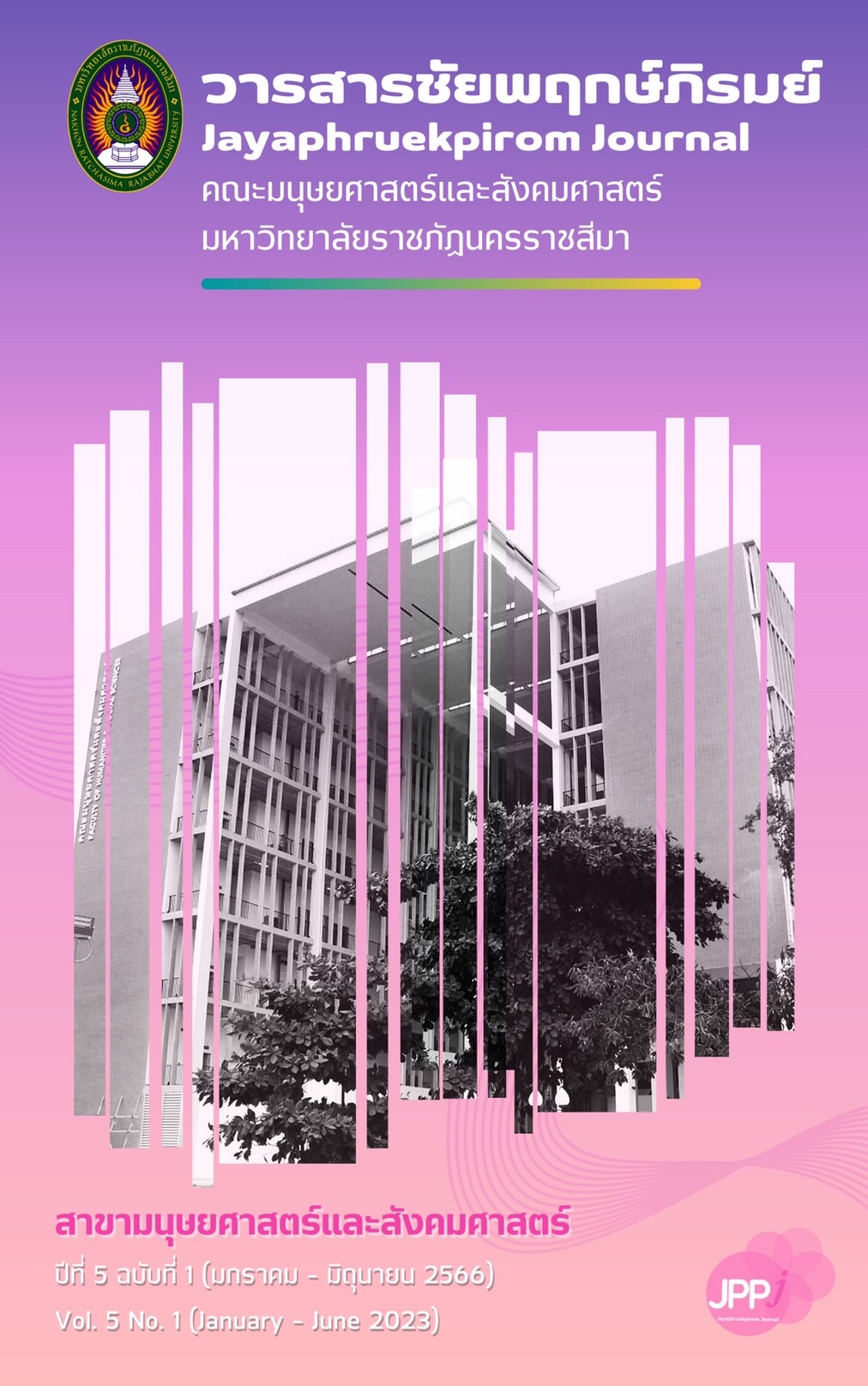THE COMPARISON OF BELIEFS AND ETHICS IN THE SONDONTA TRADITION OF THAI PEOPLE OF KHMER DESCENT IN VILLAGE NO. 6, BAN SOMBAT CHAROEN, KUT BOT SUB-DISTRICT, SOENG SANG DISTRICT, NAKHON RATCHASIMA PROVINCE
Keywords:
Thai people of Khmer descent, Sandonta, Festival of the 10th month, Ancestor ghost, Doctrines.Abstract
This research aimed 1. to compare beliefs in the Santana tradition of Thai people of Khmer descent, in Village No. 6, Ban Sombat Charoen, Kut Bot Subdistrict, Soeng Sang District, Nakhon Ratchasima Province with Buriram, Surin and Sisaket provinces, and 2. To analyze the morals in the Sandonta tradition of Thai Khmer people in Village No. 6, Ban Sombat Charoen, Kut Bot Sub-district, Soeng Sang District, Nakhon Ratchasima Province. This research is a qualitative research. The researcher researched and gathered data from the research works, research reports, academic articles, journals, books, writings, and other related media. The research tool was interview. And, the collected data were analyzed using descriptive analysis for further presentation of the research results.
The results of the research showed the villagers in Village No. 6, Ban Sombat Charoen, Kut Bot Subdistrict, Soeng Sang District, Nakhon Ratchasima province believe that the Santana Tradition is the tradition to express gratitude and to remind them of their deceased ancestors. It is a merit making dedicated to grandparents, grandparents, and ancestors in order to show the appreciation of the benefactors and gratitude to their ancestors.
The Santa Cruz Tradition is inserted with Dharma teachings as follows. 1. Gratitude expressed by children or younger generation by joining together to make merit and dedicate the merit to their ancestors. 2. Unity, in the Sandonta tradition expressed by the villagers in the community through jointly preparing food together, making Khao Tom together to make Krayasart. 3. Giving or donation expressed through the way that villagers bring snacks they made to distribute to neighbors, the poor, and people in the community. And, 4. forgiveness of which gran parents, parents, and elder relatives forgive their children along with blessing.
References
ณรงค์ เส็งประชา. (2529). พื้นฐานอารยธรรมไทย. กรุงเทพฯ: โอเดียนสโตร์.
ธวัช ปุณโณทก. (2528). วัฒนธรรมพื้นบ้านคติธรรมความเชื่อ ในวัฒนธรรมพื้นบ้าน : คติธรรมความเชื่อ.
กรุงเทพฯ: โรงพิมพ์จุฬาลงกรณราชวิทยาลัย.
นวล ดีสาหะ. การสื่อสารระหว่างบุคคล. สัมภาษณ์วันที่ 11 มีนาคม 2565
บุญมี เอื้อนไธสง. การสื่อสารระหว่างบุคคล. สัมภาษณ์วันที่ 10 มีนาคม 2565.
บันเทิง บุตรเทศ. (2559). พิธีกรรมและความเชื่อแซนโฎนตาของชาวบ้านละลม จังหวัดสุรินทร์. วารสาร
ออนไลน์มหาวิทยาลัยสุโขทัยธรรมาธิราช, สืบค้นเมื่อ 27 พฤศจิกายน 2564.
ปิยลักษณ์ โพธิวรรณ์ และยุภาพร ยุภาศ. (2559). กระบวนการสร้างพื้นที่ทางสังคมของผีอีสาน รายงานการ
วิจัยสาขาวิชารัฐศาสตร์ คณะรัฐศาสตร์และรัฐประศาสนศาสตร์ มหาวิทยาลัยราชภัฏมหาสารคาม
(รายงานการวิจัย). กรุงเทพฯ: สำนักพิมพ์จุฬาลงกรณ์มหาวิทยาลัย.
พระครูรัตณญาณ โสภิต และพระมหามิตร ฐิตปญโญ. (2562). ความเชื่อในประเพณีแซนโฎนตาของจังหวัด
บุรีรัมย์. วารสารวิชาการธรรมทรรศน์. 19(3), น. 285-293.
พระครูรัตณญาณ โสภิต. (2563). การอนุรักษ์ประเพณีแซนโฎนตาที่มีผลต่อวิถีชีวิตของชาวอำเภอสตึก
จังหวัดบุรีรัมย์. วารสารสันติศึกษาปริทรรศน์ มจร. 8(2), น. 561-571.
เมธาวี. (2556). ประเพณีประดิษฐ์กับการจัดการทรัพยากรวัฒนธรรม : กรณีศึกษางานเทศกาลประเพณี
แซนโฏนตา อำเภอขุขันธ์ จังหวัดศรีสะเกษ. (วิทยานิพนธ์หลักสูตรปริญญาศิลป ศาสตรมหาบัณฑิต,
มหาวิทยาลัยศิลปากร).
วิเชียร รักการ. (2534). วัฒนธรรมและพฤติกรรมของคนไทย. กรุงเทพฯ: โอ.เอส.พริ้นติ้ง.เฮ้าส์.
สมศักดิ์ ป้องปัญจมิตร และขนิษฐา จวบสุข. การสื่อสารระหว่างบุคคล. สัมภาษณ์วันที่ 10 มีนาคม 2565.
สวัสดิ์ พินิจจันทร์. (2505). คติธรรม. กองวัฒนธรรมกรมการศาสนา กระทรวงศึกษาธิการ. โรงพิมพ์
การศาสนา.
สองเมือง สวัสดี. การสื่อสารระหว่างบุคคล. สัมภาษณ์วันที่ 11 มีนาคม 2565.
สารภี ขาวดี. (2559). ประเพณีแซนโฏนตา: การสืบทอดและการดำรงอยู่ในบริบทพื้นที่ดั้งเดิม. วารสาร
มนุษยศาสตร์และสังคมศาสตร์. 7(2), น. 131-163
สุภาพร ลาธุลี, อิทธิวัตร ศรีสมบัติ และชาตรี เกษโพนทอง. (2559). การศึกษาประเพณีแซนโฎนตาของบ้าน
ทวารไพร อำเภอจอมพระ จังหวัดสุรินทร์. วารสารวิชาการ มจร บุรีรัมย์. 3(1), น. 1-13


